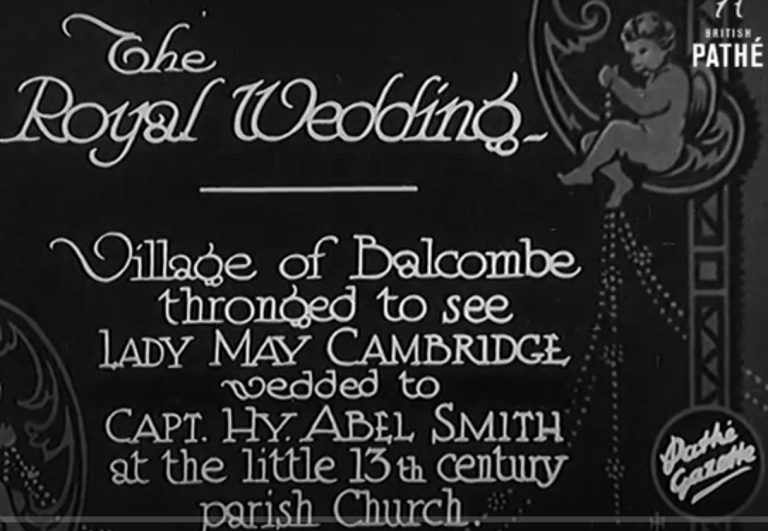History
There has been a church on this site since 1090 with present church building dating back to the late 1200s to early 1300s.
The history can be traced back to the first rector in 1333 and the church has hosted a royal wedding.
A Royal Wedding 1931
In 1931 a Royal wedding was held in St Mary's Balcombe, with Queen Elizabeth II as a young bridesmaid. She was 5 years old at the time.
The wedding is between Lady May to Henry Abel Smith on 24 October 1931.
We have a commemorative plaque in the front row pew where Queen Mary sat.

From British Pathe News
"Sussex. The Royal Wedding"
"Village of Balcombe thronged to see Lady May Cambridge wedded to Capt. Hy. Abel Smith at the little 13th Century Church."
From British Pathe News
ROYAL: Princess Elizabeth at Wedding of Lady May Cambridge (1931)
17 year old Lady May Cambridge had been a bridesmaid to Lady Elizabeth Bowes-Lyon in 1923. Here the compliment is reciprocated with the now Duchess of York's 5 year old daughter Princess Elizabeth acting as bridesmaid. The wedding of Lady May to Henry Abel Smith took place at Balcombe village, near Haywards Heath, Sussex on 24 October 1931.
(Abridged version)
The setting
There was a church on this site by 1090, when records show that it was given to the Priory of St Pancras at Lewes, including a levy of tithes to support the church and clergy. The present church was classified in 1987 on the statutory list of buildings of special architectural or historic interest as Grade 1 (the highest listing). The Parish Registers date back to 1539; the originals are now housed at the West Sussex Record Office in Chichester. There have been seven key stages in the building and development of the present church and its surroundings. A useful starting point is the painting of St Mary’s in 1805 before the almost total rebuilding began in 1847 a copy of which hangs on the wall near the south door.
The tower
The sandstone tower with its oak-shingled broach spire was built rather later, in the 15th century. The window at the base of the west wall was originally a door leading directly into the church.
The belfry has a ring of eight bells, three of them dating back to 1614. Three others were hung in 1878, and two more were given by parishioners in 1936 to commemorate the Silver Jubilee of King George V the previous year. At the same time five of the old bells were recast, tuned and toned by Gillett and Johnson of Croydon.
Maintenance, repairs and alterations
Any old building requires constant care and attention, and this church is no exception. Over many years, major repairs have been needed to the sandstone walls; the Horsham stone slabs and clay tiles to the roofs; the oak shingles on the spire; damage caused by damp penetration; wood rot in floors and other woodwork; replastering of ceilings; and complete internal redecoration. Some of the cost has been grant-aided, but a large proportion has been given by parishioners and visitors throughout the ages.
The outside of the church
St Mary’s has the pleasant, unpretentious, look of a small country church of mainly Victorian origin, without special architectural merit. The walls are built from local sandstone all cut from the same quarry over several hundred years up to the present day. The main roof facing south is clad with Horsham stone slabs, with plain clay tiles elsewhere. The broach spire is in oak shingles. The roof was retiled in 1988, as commemorated by a wooden plaque inside by the door to the rector’s vestry.
Memorial furniture and displays
Apart from the memorial windows there are other plaques and commemorations throughout the church. Above the rector’s stall in the chancel is a brass plate listing all the rectors since 1333, around 50 of them, some serving almost the same number of years. A memorial to Balcombe men who died in both world wars is next to the British Legion window in the north aisle, and is the focus of the annual Remembrance Day service when all the names are read out.
The Lychgate
The winding path up to the church from the road through a gap in the hedge, had always been a rather undistinguished entrance to the church itself: it needed a stronger focus. To celebrate the Millennium, English Heritage Buildings sponsored a competition throughout the south east to donate a lych gate to the most deserving church.
Stained glass windows
The large west window in the nave (illustrated) is in memory of George and Fanny Amilia Meek, of Brantridge, who died on December 8th and 13th 1874 respectively. He was High Sheriff of Sussex who caught a fever at Lewes Assizes, of which he and his wife both died. It depicts the arrival of the kings. A separate leaflet is being prepared describing the other windows and monuments.
Wall paintings
Painted biblical texts abounded in the late nineteenth century around the walls and following the shape of the arches in the nave and aisle arcades. Over the window above the main altar, for example, was an elaborately painted text "Unto us a child is born: unto us a child is given". Sadly, all these texts had been painted over by 1900.
The following websites add further reading:
Parish Information
St Mary's Church is a Registered Charity No: 1175472
© Copyright. All rights reserved.
We need your consent to load the translations
We use a third-party service to translate the website content that may collect data about your activity. Please review the details in the privacy policy and accept the service to view the translations.



